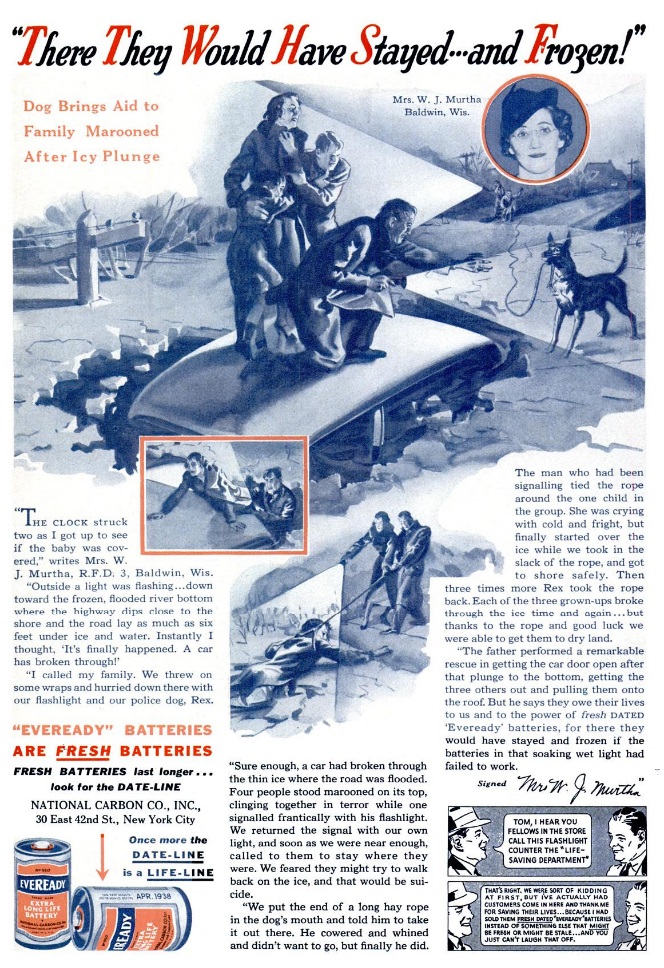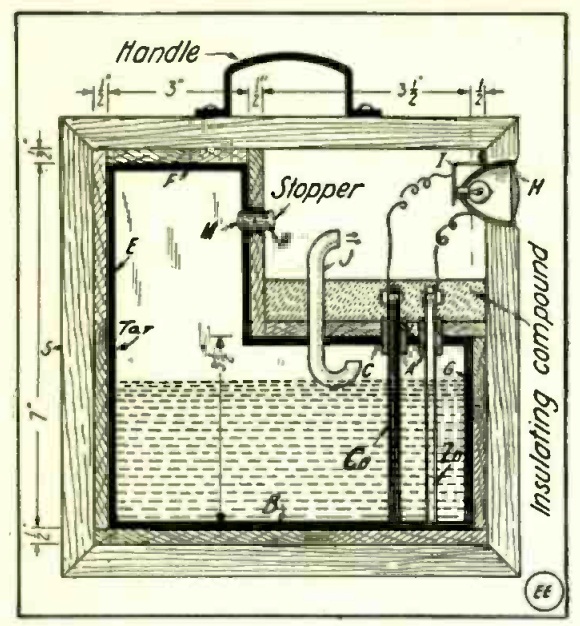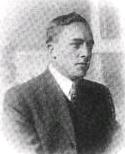 This ad from the February 1938 issue of Popular Science shows once again the importance of keeping fresh batteries in your flashlight.
This ad from the February 1938 issue of Popular Science shows once again the importance of keeping fresh batteries in your flashlight.

 This ad from the February 1938 issue of Popular Science shows once again the importance of keeping fresh batteries in your flashlight.
This ad from the February 1938 issue of Popular Science shows once again the importance of keeping fresh batteries in your flashlight.
75 years ago, Americans were preparing for the possibilities of blackouts in case of enemy air raid. In this day’s issue of Life magazine, June 15, 1942, Eveready carried this ad explaining the importance of keeping a flashlight, and how to use it during a blackout.
The ad first admonished that every home should have one or more flashlights, but that before buying new ones, old ones should be inspected to see if they could be repaired. In many cases, only a new bulb or lens, or a fresh set of batteries was required. The flashlight should be kept in a convenient accessible spot, and always put back.
During a blackout, it was important to never point the light toward an unshielded window, skylight, or open door. Outside, the flashlight should be shielded. This could be accomplished by covering the lens with two layers of newspaper.
If unshielded, the flashlight should be used outside only when absolutely necessary, taking care to never point it even slightly upward, and never toward reflective objects.
And, of course, the flashlight should have Eveready batteries, with an extra set of spares.

If you’re looking for a good inexpensive flashlight, I recommend the modern one shown at the left. For just a few dollars, you get a reliable light with a long lasting battery, and replacement batteries will only set you back a few cents.
But a hundred years ago, while handheld flashlights were available, they were more expensive and less reliable. So the economy minded handyman might consider the idea of just making his own, battery and all. The self-explanatory diagram shown at the top of the page, taken from the December 1916 issue of Electrical Experimenter, shows exactly how it can be done. The great advantage of this do-it-yourself model was that it didn’t even require a switch. You just set the light on its side, all of the electrolyte would slosh to the compartment on the left, and the light would extinguish.
The lamp is built from nice thick pieces of hardwood, which securely contain the acid sloshing around inside. What could possibly go wrong? Well, what could go wrong is hinted at by this admonition in the instructions:
The next, and perhaps the most important step, to be taken in the construction of the portable battery lamp, is to seal up the battery jar so as to make it absolutely acid-proof. To prevent the acid from leaking out of the jar the cracks can be filled up by applying a thin coat of molten pitch or asphalt around the inside walls of the jar, as indicated by the heavy black line. This can be done very well by melting a few pounds of asphalt in a kettle and pouring a small quantity through the rubber tube holes at A, tilting the whole case so that it will run into all the corners; then permit it to cool. Additional molten tar is added until every crevice and surface of the interior is thoroughly coated with the insulating and acid-proof material.
After this acid-proof container is thus constructed, the interior is filled with a solution of sulfuric acid. When the lamp is set as shown in the diagram, the bulb should glow brightly.
This is presented as inspiration for a science fair project, but even I would recommend that aspiring scientists contemplating a similar project should make a few more concessions to safety. The school janitor probably won’t be very pleased if some sulfuric acid leaks out of your wooden “jar” onto the floor of the school gymnasium. And mom probably won’t appreciate it if you melt a few pounds of asphalt in one of her kettles. But the general concept is sound. It’s quite possible to make your own battery capable of generating honest to goodness electrical current. For more ideas on other homemade batteries, you can visit my earlier post on the subject. You can find other science fair ideas at this link.
This advertisement for Eveready batteries appeared 75 years ago this month in the November 1936 issue of Popular Science. I had never heard of the Zamzam, but her last voyage is a fascinating but forgotten story of the Second World War.
I haven’t found any independent verification of the claim in the ad, that the Captain used Eveready batteries to avert disaster. But whether or not he did, it’s a compelling story.
The Zamzam set sail from New York in the Spring of 1941 under the Egyptian flag, bound for Egypt by way of South America and South Aftica. Built in 1909, she originally bore the name Leicestershire and flew the British flag. She first served as a passenger ship to India, and during the First World War, she served as a troop carrier, carrying troops to Russia and repatriating Australian troops after the war. After the war, she was modernized to burn oil rather than coal, and resumed passenger service to Rangoon until 1930.
In that year, she was sold to the British National Exhibition Ship Company Ltd., and was renamed the British Exhibitor, where she was to serve as a floating expedition showcasing goods throughout the Empire. When that company went into liquidation, the ship was purchased by the Egyptians, where she transported 600 pilgrims at a time from Suez to Mecca for the next eight years.
With the outbreak of war, the Zamzam was pressed into service carrying passengers between Egypt and New York. The first trip to New York was apparently uneventful, but her last voyage was the return trip.
The ship left Hoboken, New Jersey, on March 20, 1941, with 201 passengers aboard. To avoid war zones, the neutral ship would sail to Trinidad, thence to Recife, Brazil, across the Atlantic to Capetown, South Africa, and then up the east coast of Africa to Mombasa, Kenya, and then to Alexandria, Egypt.
The largest contingent of passengers consisted of 144 missionaries, representing both Catholic and Protestant denominations. Interestingly, the contingent of missionaries from the Augustana Lutheran Church were on their way to Tanzania, where they were to replace German Lutheran missionaries interned by the British.
The passengers also included a group of ambulance drivers from the British-American Ambulance Company, en route to North Africa to serve as ambulance drivers for British forces. There were also a group of American tobacco buyers en route to Rhodesia. Most passengers were American, but there were a large number of Canadians. The missionaries in particular included many women and children among their numbers.
Joining the passengers in Brazil were Life magazine photographer David E. Scherman and Fortune magazine editor Charles J.V. Murphy, who documented the later sinking.
A few days after leaving New York, the passengers were startled when the crew began painting over the portals and announcing that the ship would be travelling in strict blackout conditions. This prompted considerable protest by the passengers, who had believed that they would be traveling openly under the protection of a neutral flag. The captain, a British officer, insisted that he was acting under orders of the Admiralty, to the great consternation of passengers. The ship traveled under strict blackout, and no light, not even a lit cigarette, was permitted on deck.
During the early morning hours of April 17, the German raider Atlantis (also known as the Tamesis), a reflagged Norwegian freighter, attacked. The passengers donned life jackets and boarded lifeboats and the ship sunk. Since some of the lifeboats had been damaged, a number of passengers were forced to float in the water.
Just as the raider hoisted its Nazi flag and its crew were stationed at machine guns, a rainbow appeared in the morning sky. Eventually, the survivors signaled (presumably with the captain’s Eveready flashlight) that the ship was neutral. The German ship took the survivors aboard, and the captain discovered to his dismay that many of the passengers were Americans.
By all accounts, the captain, Bernhard Rogge, treated the prisoners humanely, and they were transferred a few days later to another ship which eventually transported them to occupied France. The Americans were repatriated fairly rapidly through Spain and Portugal, but the Canadians were interned.
The Catholic missionaries were American born, but were traveling under Canadian passports to expedite entry into South Africa. In retrospect, the decision was undoubtedly regretted, since they were interned with the other Canadians. This turned out to be a fortunate circumstance for the Germans, since the Geneva Convention required them to provide chaplains for POW’s, a role which these prisoners took on.
Eventually, seven of the Canadian women were to be exchanged for German women being held in Canada. At some point, they were placed on a train to Berlin. Unfortunately, nobody had bothered to tell Berlin that they were coming, and they were left to their own devices in the enemy capital. They made contact with American journalists and diplomats, and were eventually returned to Canada.
During their stay, however, they were forced to obtain food in the local economy along with the Germans. One butcher, recalling his humane treatment by the allies as a prisoner in the previous war, greeted them in English each time they entered his shop, and allowed them to the front of the line, somewhat to their embarrassment.
This video, prepared by one of the predecessors of the Evangelical Lutheran Church in America, is a fascinating look at the bizarre odyssey of these missionaries.
References
Seventy years ago, this day’s issue of Life Magazine, August 26, 1946, showed you exactly what to do if you were lost in the woods at night, courtesy of this advertisement by Eveready.
According to the ad, as long as you had common sense and an Eveready flashlight loaded with Eveready batteries, you would come through. The first piece of advice was that you’re never really lost until you lose your head. Therefore, the best course of action was not to travel at night. Instead, you should use your flashlight to gather boughs and leaves for a bed, and build a fire.
Once you made your primitive camp, the next course of action was to signal SOS with your flashlight–three short, three long, three short. This would guide searchers, especially if you had Eveready batteries, which would send hundreds of such brilliant penetrating light signals.
When morning came, the best bet was to stay put and wait for help to come. But if travel was necessary, you should douse your fire and follow any running water downstream.
In addition to the Eveready flashlight and batteries, the ad reminded that other survival necessities included matches in a waterproof case and a compass. These needs should be with you on every outing.
Click Here For Today’s Ripley’s Believe It Or Not Cartoon
![]()
The radio retailer 80 years ago was always looking for a way to add a few more sales, and with summer vacation season underway, one idea was this counter top battery display for the obligatory flashlight. The display took up only 8-1/2 by 11 inches of counter space, but promised to keep customers shelling out for cells.
The ad, from the Bond Electric Corporation of New Haven, CT, appeared in the July 1936 issue of Radio Retailing magazine.
Click Here For Today’s Ripley’s Believe It Or Not Cartoon
![]()
Building an online therapy practice
The March 1915 issue of The Wireless Age carries the tale of the steamship Chester, a tanker owned by the American Petroleum Company. She had left New York on January 23 en route to Rotterdam with a cargo of oil. She ran into rough weather a few days out and suffered a tank bulkhead burst, but there was no immediate peril.
But on the afternoon of February 2, a giant wave swept over the vessel. The hatches were demolished and oil was pouring from the tanks. The engines were flooded and stopped; most of the contents of the deck, including the lifeboats were swept away; and the ship was listing so badly that the rails were in the water.
The ship was not equipped with wireless, but the second officer, Jacobus W. Waale, held a cargo grade wireless certificate and was familiar with Morse. With the one remaining signalling lamp and a flashlight, he began to signal SOS over the dark waves. All that night, no ship spotted the signal. The next day, signal flags were hoisted, also to no avail. When darkness once again fell, Waale once again resumed signalling with the lights.
Fortunately, the steamer Philadelphia was making its way from Liverpool to New York. Normally, she would have been on a more southerly route, but had moved closer to the Chester’s position in an effort to avoid storms. A tiny spark of the Chester’s light was spotted from the deck of the Philadelphia, and the officers finally realized that a ship was trying to signal them. One of the officers had some knowledge of Morse Code and made out that it was an SOS. The captain instructed the wireless operator J. Edward Jones to establish contact with the signalling ship. This, of course, was in vain, since the Chester was not equipped with wireless. The ship’s second wireless operator, William V. Moore, was summoned to the deck to make contact with the signal light.
He flashed the message, “what is the matter?” It took almost thirty minutes to receive the reply, “we are a wreck.” The Philadelphia inquired as to whether the distressed ship had any boats, to which it received a negative reply. When asked “do you want to be taken off,” the Chester replied “yes.” The rescue was not easy, but it was facilitated by the use of the lights.
Interestingly, this incident came just a few months after another notable incident involving a flashlight used to send SOS from the Hanalei recounted in an earlier post.
A hundred years ago this month, the February 1915 issue of Popular Mechanics reported the story of Loren A. Lovejoy, the wireless operator of the steamer Hanalei, shown here in this artist’s rendition.
The Hanalei suffered a shipwreck on November 23, 1914. While the incident is almost forgotten today, more than twenty of the 63 aboard the ship perished off Point Bolinas, 14 miles north of the Golden Gate. Even though the ship was within 500 feet of land and it was daylight when it hit the rocks, the rescue proved difficult. The ship initially made an incorrect report of its position. By the time rescuers realized the correct location, fog was setting in, and it was late at night before any rescue could be attempted. By then, the ship’s radio had been destroyed. Trucks transporting the rescuers had to travel 60 miles on poor roads in heavy fog.
To communicate with the rescuers, Lovejoy was able to signal using Morse code with a flashlight. Those ashore were able to send “words of cheer” with automobile headlights. With a mortar, the rescuers would shoot a lifeline to the ship. Lovejoy then sent messages back such as “windward and too low. Send her higher.”
The Secretary of Commerce later sent a personal letter commending Lovejoy for “his courage and ingenuity, measuring up to the high standards of the wireless service.”
Lovejoy was born in Hillsdale, Kansas, on June 27, 1891, and graduated from high school in Seattle. He entered service with the Marconi Company in 1912. He died in 1977.
The Seattle Star reported in the next day’s paper that Lovejoy was killed in the shipwreck. In fact, it was the Star’s reporter who communicated that sad news to Lovejoy’s father. The newspaper account, however, was greatly exagerated, and Lovejoy lived another six decades, Lovejoy survived the wreck. He is pictured in the 1960’s in White’s book linked below. His First Grade operator’s license was listed as being renewed in December, 1916.
According to the Social Security Death Index, Lovejoy died in 1977 at the age of 86 in the Seattle area. He is buried at Acacia Memorial Park in King County, Washington.

Adolph Svenson. Wireless Age, Jan. 1915.
The Hanalei was originally constructed for the Hawaiian sugar trade, but was in service at the time of its wreck hauling lumber and passengers between Northern California and San Francisco.
The Hanalei’s assistant wireless operator, Adolph J. Svenson, who sent out the first SOS, was among those killed in the wreck. He drowned when the ship broke up. Lovejoy later recounted of his colleague, “throughout our terrible experience he remained cool and resourceful, upholding in an exemplary manner the traditions of the Marconi service.” Svenson’s name is among those inscribed in the Wireless Operators Memorial in Battery Park, New York, which was dedicated on May 12, 1915.
References